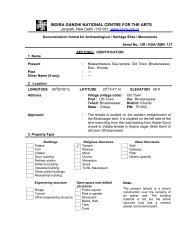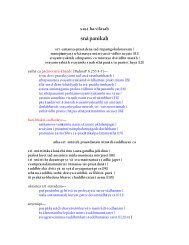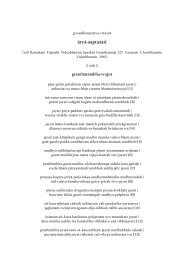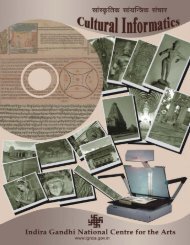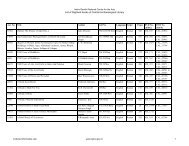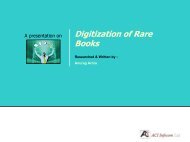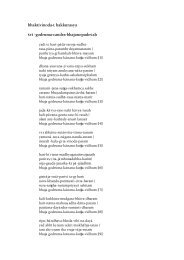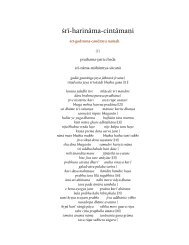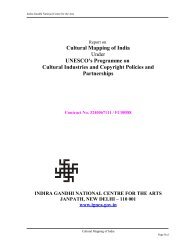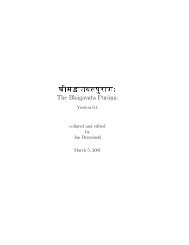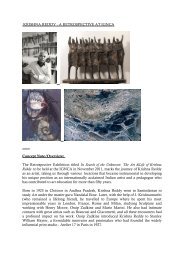sdfsf sf - Indira Gandhi National Centre for the Arts
sdfsf sf - Indira Gandhi National Centre for the Arts
sdfsf sf - Indira Gandhi National Centre for the Arts
Create successful ePaper yourself
Turn your PDF publications into a flip-book with our unique Google optimized e-Paper software.
<strong>Indira</strong> <strong>Gandhi</strong> <strong>National</strong> <strong>Centre</strong> For <strong>the</strong> <strong>Arts</strong>, New Delhi, India<br />
Carla M Sinopoli, See Kathaleen D. Morrison, 1996.<br />
* * *<br />
Carla M. Sinopoli, Ear<strong>the</strong>n ware Pottery of Vijayanagara some observations,<br />
Ed. M. S. Nagaraja Rao, Vijayanagara Progress of Research, 1979-83,<br />
Directorate of Archaeology and Museums, Mysore, pp -<br />
This article deals with <strong>the</strong> pottery of Vijayanagara. The study includes<br />
<strong>the</strong> pottery collected in <strong>the</strong> excavated sites but also in <strong>the</strong> various suburbs of<br />
Vijayanagara. The production, distribution, marketing of pottery are dealt<br />
here. There are illustrations of various pottery.<br />
Carla M. Sinopoli and Kathleen D. Morrison, The Great Metropolitan Region.<br />
New Light on Hampi – Recent research at Vijayanagara, Eds. John M. Fritz<br />
and George Michell, Marg Publication, Bombay 2001, pp. 101-111.<br />
This article elucidates <strong>the</strong> Vijayanagara metropolitan survey work<br />
carried out to document <strong>the</strong> archaeological evidences from <strong>the</strong> area<br />
surrounding <strong>the</strong> core of Vijayanagara capital. The Forts and roads, <strong>the</strong><br />
agricultural and craft production area, <strong>the</strong> sacred sites are some of <strong>the</strong> points<br />
which are dealt in this article, In <strong>the</strong> greater area <strong>the</strong>re are many sites of<br />
which some are considered to be sacred, and some o<strong>the</strong>rs are of <strong>the</strong> Muslim<br />
habitation.<br />
Debala Mitra, Indian Archaeology – A Review 1979-80, Archaeological<br />
Survey of India, New Delhi 1983, pp 133.<br />
This article deals with <strong>the</strong> excavations conducted in <strong>the</strong> main area at<br />
Hampi and <strong>the</strong> details of <strong>the</strong> important finds are noted.<br />
Debala Mitra, Indian Archaeology – A Review – 1980-81, Archaeological<br />
Survey of India, New Delhi, 1983, pp 26-27.<br />
This article deals with <strong>the</strong> excavations conducted by Archaeological<br />
Survey of India, near Kings audience hall and <strong>the</strong> mint area. The different<br />
structures exposed during excavation are recorded.<br />
Debala Mitra, Indian Archaeology – A Review, 1981-82, Archaeological<br />
Survey of India, 1984, pp, New Delhi, 25-26.<br />
This article deals with <strong>the</strong> excavation conducted in <strong>the</strong> Royal<br />
Enclosure area particularly Kings audience hall, Mahanavimi Dibba and in<br />
Mint area. The different structural phases are noticed in <strong>the</strong> excavation.<br />
Bibliography on Hampi – Archaeology Articles<br />
6



